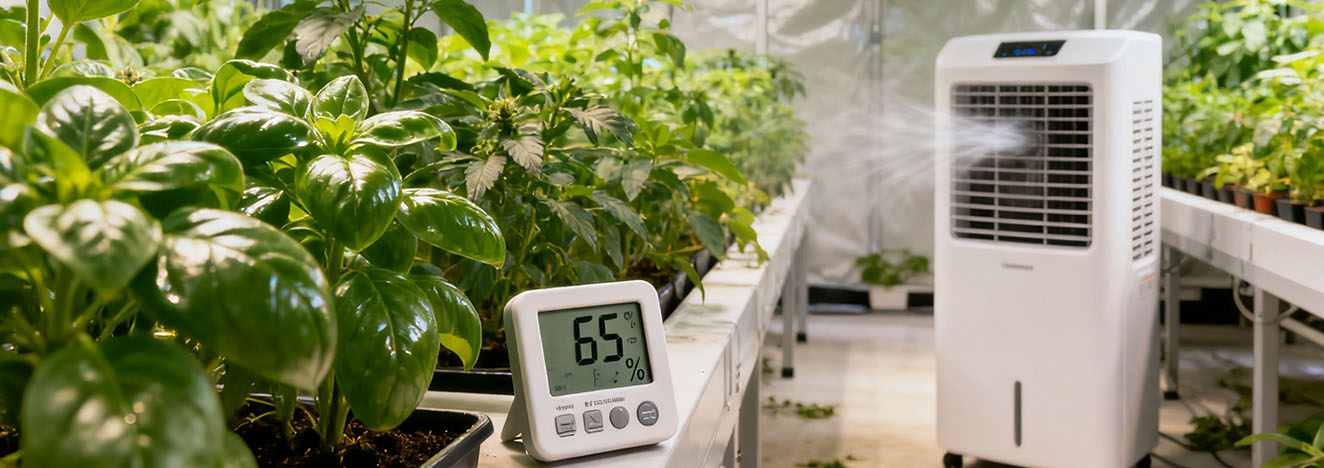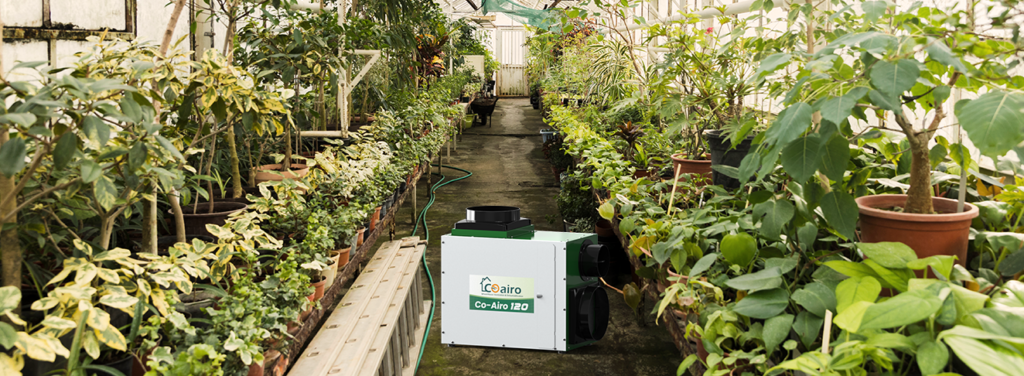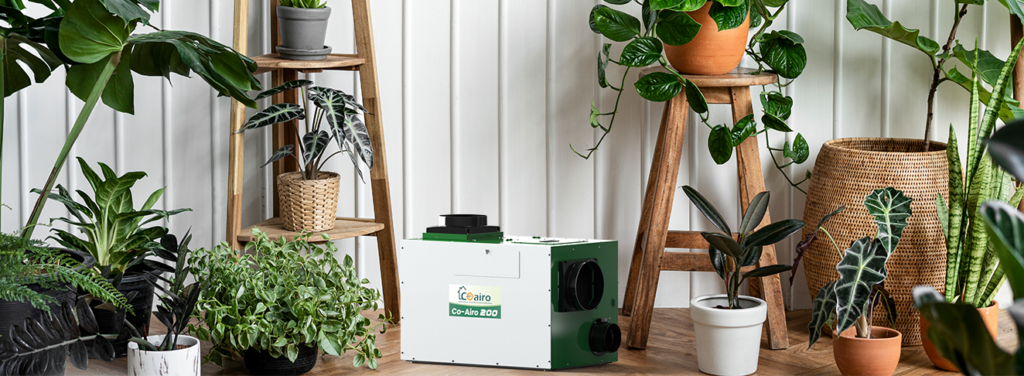Introduction
Maintaining proper humidity is essential for successful indoor farming. Excess moisture can lead to mold and mildew, while insufficient humidity can hinder plant growth. A grow room dehumidifier is a vital tool to achieve optimal humidity management, but selecting the correct size is critical.
How do you determine what size dehumidifier do I need? This guide provides clear steps, using a dehumidifier size calculator and a dehumidifier size chart, to ensure effective grow room dehumidification. By understanding your grow tent size and other factors, you can create a healthy environment for your plants.
The Role of Humidity in Indoor Farming
High moisture content in a grow room can cause serious issues that damage the plants. According to the study conducted by Hydrobuilder, plants release approximately 97% of the water they absorb through transpiration. In enclosed spaces like grow tents, this moisture accumulates quickly, especially in humid climates or hydroponic systems. A grow room dehumidifier addresses this by drawing air over cold coils, condensing water vapor into a reservoir, and releasing drier air, as described by Consumer Reports.
Optimal humidity levels depend on the plant growth stage:
| Growth Stage | Optimal RH (%) |
|---|---|
| Seedlings / Clones | 70 – 75% |
| Vegetative Stage | 50 – 70% |
| Flowering Stage | 40 – 50% |
Without proper grow room dehumidification, plants may suffer from mold, mildew, or nutrient uptake issues. An incorrectly sized dehumidifier can dry the air too much or raise the energy bills unnecessarily.
Benefits of Using a Dehumidifier for Indoor Plants
A grow room dehumidifier offers multiple advantages for indoor plant care:
Prevent Mold and Mildew: Maintaining humidity between 40-60% reduces the risk of mold, as noted by Quest Climate.
Enhance Nutrient Uptake: Proper humidity ensures plants absorb nutrients efficiently, avoiding problems like root rot, as per Growers House.
Reduces Allergens: Dehumidifiers filter out pollen, dust mites, and other pollutants, improving air quality for plants and growers.
Lower Energy Costs: Dry air feels cooler, reducing reliance on air conditioning, as highlighted by Spider Farmer.
These benefits make dehumidifiers essential for both small grow tents and large-scale commercial humidity solutions.
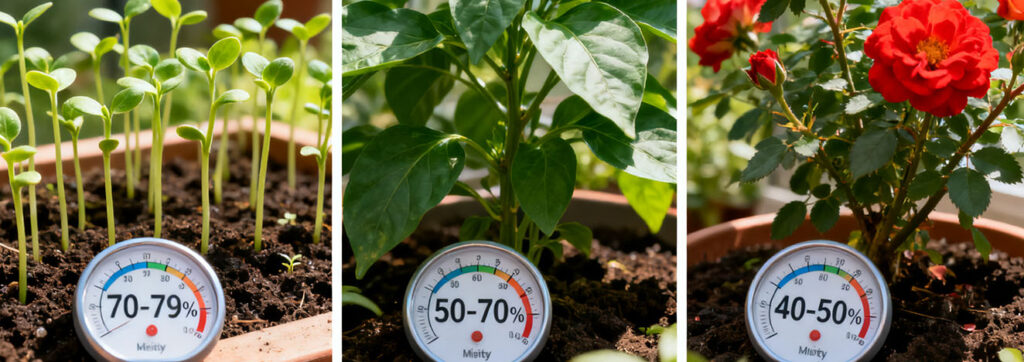
Factors to Consider When Sizing a Dehumidifier
Selecting the right grow room dehumidifier requires evaluating several factors, such as the size of your grow room space, current humidity levels, environmental conditions, and plants’ requirements. Below are the key steps to guide your decision.
1. Determine Your Grow Room’s Size
Measure the length, width, and height of your grow tent in feet to calculate the volume in cubic feet. For example, 4ft x 4 ft x 8ft = 128 cubic feet.
Alternatively, calculate square footage by multiplying length by width (e.g., 4 ft. x 4 ft. =16 square feet). This measurement is critical for using a dehumidifier size calculator as recommended by Preair. Larger spaces require higher capacity dehumidifiers to achieve effective humidity management.
2. Calculate Water Removal Needs
Plants release most of the water they receive through transpiration. A useful formula, provided by Quest Climate, is:
Daily water usage (gallons) x 8 = Pints Per Day (PPD
For example, if 10 plants receive 1 gallon of water daily, that’s 10 gallons x 8 = 80 PPD. Another method described by GrowGeneration is to multiply the grow room’s cubic feet by 0.75. For a 128 cubic foot space: 128 x 0.75 = 96 PPD
This estimate helps determine the required capacity of the dehumidifier.
3. Assess Humidity Levels
According to DryGair, most plants thrive at 40-60%. Use a hygrometer to measure your grow room’s humidity. If levels exceed 60%, particularly in humid climates, a larger dehumidifier is necessary. Add 10 PPD for high-humidity environments, as advised by Dehumidifier Corporation of America. Regular monitoring is essential, as humidity can fluctuate with temperature or watering changes.
4. Evaluate Environmental Conditions
Environmental factors influence humidity management:
Ventilation: One Stop Grow Shop suggested that ventilation systems with constant air exchange might reduce the efficiency of the dehumidifier.
Temperature: Maintain 65-75 0F for optimal plant growth. In humid or cool climates, a dehumidifier may need to work alongside an air conditioner.
Insulation: A poorly insulated space allows external moisture to enter, requiring a larger unit.
5. Select Appropriate Dehumidifier Features
Choose a dehumidifier with features suited to indoor plant care as recommended by Spider Farmer:
Built-in Humidistat: Automatically maintains desired humidity levels.
Continuous drainage: Eliminates the need to empty water tanks, ideal for commercial humidity solutions.
Energy efficiency: Units with high pints-per-kWh ratings reduce operating costs.
Coairo’s 90 PPD whole-house dehumidifier offers high pints per kWh ratings, efficiently removing moisture to lower operating costs for your grow room.
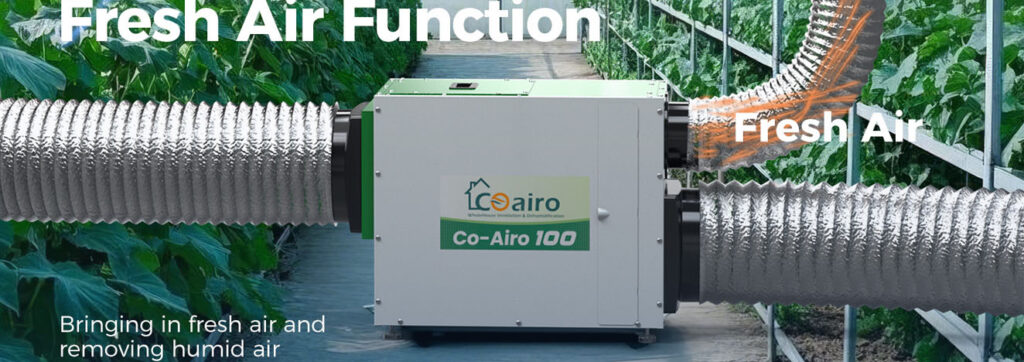
Using a Dehumidifier Size Chart
A dehumidifier size chart simplifies the selection process. Based on Growgeneration, typical capabilities include:
| Grow Tent Size | Square Footage | Recommended PPD |
|---|---|---|
| 4 × 4 ft | 16 sq ft | 30 – 50 |
| 5 × 5 ft | 25 sq ft | 50 – 70 |
| 10 × 10 ft | 100 sq ft | 60 – 100 |
| Commercial Spaces | > 100 sq ft | > 100 |
For home growers with 10×10 tents (or smaller), the Co-Airo 100 dehumidifier fits perfectly—it hits the 60-100 PPD sweet spot while covering up to 2,300 sq. ft. For large commercial grow tents, the Co-Airo 200 dehumidifier removes up to 165 pints daily, keeping 4,500 sq. ft. dry. It also includes a built-in pump and auto-defrost feature, making it reliable in any season.
Why Coairo Dehumidifiers are the Superior Choice
Coairo’s are designed to meet the needs of both small-scale growers and large commercial operations. Their advantages include:
· Wide range of capacities: From 90 to 165 PPD, suitable for any grow tent size
· Energy Efficiency: Advanced compressor technology minimizes energy costs.
· Durability: Built to withstand demanding commercial and industrial environments.
· Smart Control: Compatible with controllers for seamless humidity management.
Unlike semiconductor–based units, which perform poorly in cooler conditions, Coairo’s compressor dehumidifiers remove moisture up to 39 times faster. This ensures a mold-free environment and optimal conditions for plant growth.
Common Sizing Mistakes to Avoid
Incorrect sizing can determine your efforts. Avoid these errors:
· Under-Sizing: A dehumidifier too small would not manage moisture effectively, risking mold. Round up if uncertain.
· Ignoring Heat Output: Dehumidifiers generate heat, which may require additional cooling, as noted by Hygrobuilder.
· Improper placement: Position the unit centrally for consistent humidity management.
Best Practices for Effective Dehumidification
To maximize the performance of your dehumidifier:
· Monitor Humidity: Use a hygrometer to track levels and adjust settings.
· Automate Control: Pair your Coairo dehumidifier with a controller for automated humidity management.
· Maintain Regularly: Clean filters and check drainage systems, as advised by Dehumidifier Corporation of America
· Ensure Ventilation: Adequate airflow supports photosynthesis and reduces pest risks.
Conclusion
As botanist George Washington Carver once stated, “All flowers should be allowed to bloom.” A Coairo grow room dehumidifier provides that opportunity by ensuring ideal grow room dehumidification. By using a dehumidifier size calculator and a dehumidifier size chart, you can select a unit that meets your needs, prevent mold, and promote healthy plant growth. Coairo’s energy-efficient dehumidifiers are the ideal choice for growers seeking reliable indoor plant care.
Visit Cairo’s dehumidifier collection to find the perfect solution for your grow room. Our team is available to assist with any questions, ensuring your indoor garden thrives.
